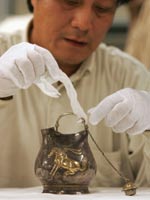
A Tang Dynasty (AD 618-907) silver pot gilded with gold is
placed into an exhibition stall. |
The
exhibition entitled "The Great Civilization of the Zhou, Qin, Han and Tang
Dynasties" at the Shanghai Museum is attracting a multitude of visitors from
home and abroad.
Yao Yi'eng, the editor of a local Chinese literature magazine and an
enthusiastic fan of the museum, says the show presents Shanghai people with the
majority of the most valuable collections from museums located in Shaanxi
Province. "This is a must-see exhibition for those who did not have the chance
to view most of the museums scattered throughout Shaanxi Province," Yao added.
Many insiders have been arguing over the list of the must-see collections on
display which started on December 29 and ends on February 15.
Chen Xiejun, the director of the museum and also the curator for the show,
said: "In fact, we have winnowed out the best of the best of almost all the
collections in Shaanxi museums."
Nevertheless, some experts have compiled a list for people who can only spend
half a day there.
The first recommendation is 11 pieces of bronze that came from the city of
Baoji, often dubbed the home of Chinese ancient bronzes due to the high number
of pieces that have been excavated from there.
The second is the world renowned Terracotta Warriors.
The Shanghai Museum has put on display more than 10 of the warriors, in
different gestures, who come from the Qin Shihuang Terracotta Warrior Museum, to
form a mini-display of the real thing.
Zhang Tinghao, an official of the Shaanxi Cultural Heritage Bureau, noted
that the two polychrome terracotta warriors among the display were the most
precious, as only eight such warriors have been unearthed. "Those going to the
Shanghai Museum are really lucky, and this will probably be a
once-in-a-life-time chance to see them."
The third category strongly recommended is the frescoes from the royal tombs
built in the Han (206 BC-AD 220) and Tang (AD 618-907) dynasties.
According to Li Lan, a senior researcher of Chinese ancient frescoes, the
fresco usually represented the social status of the tomb occupants. The exhibits
in the show fully demonstrate the top-level art of ancient painting while giving
an insight into society at the time.
The fourth category is the cultural relics of various tombs scattered around
Shaanxi.
The relic that attracts the greatest attention is the An Jia Tomb, built
during the Northern Zhou Dynasty (AD 557-581). The relics of the tomb of Sogdian
noble An Jia were excavated in a suburb of Xi'an in June 2000. According to a
researcher, An Jia, a native of An State in the then Western Region, moved to
Chang'an and settled down. He was then appointed governor and manager of foreign
trade and ritual activities in Tongzhou.
Chen Xiejun pointed out that the carvings and paintings of the stone couch
from the tomb show the life of An Jia was filled with hunting, eating and
dancing.
The fifth category is the exquisite gold and silver that was unearthed at
Hejiacun.
In 1970, two pottery jars and one silver jar were accidentally found by
several farmers when digging. That led to the discovery of more than 1,000
pieces of treasure, including gold and silver items, jade, coins and medicinal
material.
The treasures found in the underground palace of Famen Temple constitute the
sixth category.
In 1987, when renovations of the Famen Temple began, the mysterious
underground palace came to light. Over 2,400 pieces of Buddhist treasure
including the priceless sarira - a finger bone of Buddha Sakyamuni - were
discovered.

